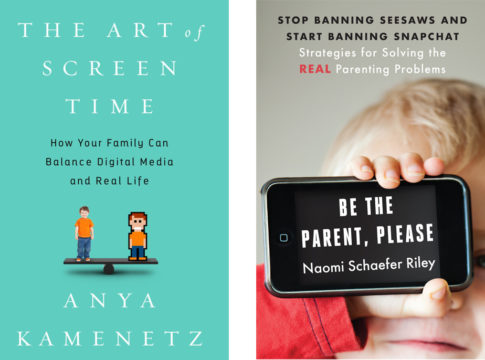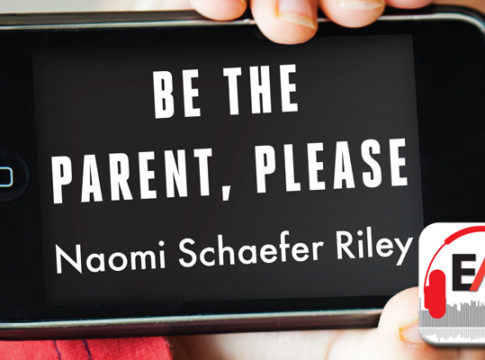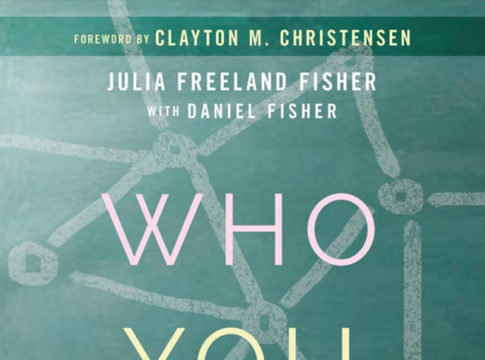Technology has changed the way kids are raised and educated. In her new book Be the Parent, Please: Stop Banning Seesaws and Start Banning SnapChat, Naomi Schaefer Riley offers parents strategies for helping children grow up with sensible boundaries as well as a sense of independence. In the following excerpt, she visits a nature club for homeschooled students, where children are developing social and emotional skills the old-fashioned way.
 A couple of months after my son started second grade, I remember him poring over an atlas on our family room floor. He asked me about finding Massachusetts on a map—that’s where his grandparents live. When I told him to look further north, he seemed puzzled. “Simon, which direction is north?” I asked. Without hesitation, he answered, “Up.” It was a perfectly logical answer for someone who liked maps but was used to seeing them pinned to the front of a classroom rather than actually using them to get places.
A couple of months after my son started second grade, I remember him poring over an atlas on our family room floor. He asked me about finding Massachusetts on a map—that’s where his grandparents live. When I told him to look further north, he seemed puzzled. “Simon, which direction is north?” I asked. Without hesitation, he answered, “Up.” It was a perfectly logical answer for someone who liked maps but was used to seeing them pinned to the front of a classroom rather than actually using them to get places.
A few weeks after this conversation, I found myself at a state park in the suburbs of Philadelphia with a group of about thirty kids ranging from toddlers to teenagers. A young man in his twenties took out a map of the park and handed a few other copies to the kids. Then he took out his compass—a couple of the kids pulled out their own as well—and asked them which way we should go to get to the trail. The kids laid their maps on the ground and quickly found the answer. “That way is north,” yelled one boy who looked to be about ten. “We need to head to the left up ahead.”
Like many of the kids at the park that day, this boy seemed confident, knowledgeable about his surroundings, and happy to talk to other kids of different ages, not to mention their parents. He was curious and excited but also surefooted and eager to warn others about pitfalls on the trail ahead.
As parents, we often have moments where we think to ourselves, “I never want my kid to act like that.” But occasionally we have moments where we look at other children and think, “I hope my child can do that too.” I hope my child can be that generous and compassionate. I hope my child can look adults in the eye and speak clearly. I hope my child can work hard at something he or she finds frustrating. I hope that when my child leaves my home to make his way in the world that he or she can exercise good judgment and restraint but also love and enthusiasm and curiosity. I hope my child can be comfortable being alone but also enjoy the company of others, even if they are not exactly like him or her. I hope my child is willing to venture into unfamiliar territory and has some thoughts on navigating it.
Not every parent’s hopes will be the same, but for the parents I’ve interviewed in the past few years, these are some of the aspirations that top the list. As goals, they are both eminently reasonable and amazingly difficult. But when you meet young adults in the world—interns, babysitters, swimming teachers, neighbors—it becomes clear quickly which of them are, to borrow a phrase, “ready to launch.”
The kids gathered at the park that day are becoming the kind of independent, self-assured, happy, curious, sociable kids that many parents today say they want. Who were they? Mostly students from the Charlotte Mason Academy (CMA). Their parents homeschool them, but once or twice a week they gather to learn subjects their parents might not have the knowledge or resources to teach them. They were black and white and Asian. They were religious and secular. They were working class and upper-middle class.
When I arrived at the park, it was just after lunch and families were starting to gather at a group of picnic tables in the shade. Some children were sitting with sketchbooks open, drawing intricate pictures of flowers and leaves. Others were climbing trees. I know it sounds like a cliché of our helicopter age that parents don’t let their kids climb trees anymore. But they really don’t. And these kids were twenty feet up. With the exception of an occasional glance, no one was monitoring their progress. Meanwhile, back on the ground, I noticed some of the kids had taken off their shoes and were playing in the dirt. And a few had wandered down to a brook nearby— again, with no immediate supervision.
Launched in 2010, CMA meets on Fridays for “Nature Club.” It has hired a couple of young men to lead the kids on hikes and teach them about some of the plants and animals they can see, as well as the ways rivers flow, rocks are formed, and so forth. The group was named after Charlotte Mason, a British educator at the turn of the twentieth century. Mason wrote several volumes on how and what to teach young people, and there are schools across the country and around the world that use her methodology. She did not like textbooks, believing that they were often written in tones too condescending to children. She thought oral presentations were very important, including the memorization and recitation of poetry. While her emphasis on music and art appreciation may not have made her theories especially unique in nineteenth-century Britain, they are today.
And her methods for teaching science have more in common with Charles Darwin’s than your typical American high school curriculum. While parents are often impressed when high schools introduce the topics of neuroscience or quantum physics, Richard Louv points out that many schools have all but stopped teaching botany and zoology. But the powers of observation that are formed from going outside and studying our immediate surroundings more deeply cannot be replicated by delving into these other important, but much more abstract, topics.
Amy Snell is one of the founders of CMA. She used to teach in a local public high school but now devotes her time to the CMA and homeschooling her own four children—three girls and a boy under the age of eleven. For many of the parents who bring their kids here on Friday afternoon, it has not been an easy adjustment. “A lot of the moms didn’t grow up in nature,” says Snell. “We try to go out in all weather,” which has bothered some of them. “There were moms who thought bugs were gross.” But watching their kids swimming in the creek, holding boat races, building forts, and even tending to campfires has been eye opening, and even inspiring, for them.
In his book How to Raise a Wild Child, paleontologist Scott Sampson describes being a little kid, going on a walk with his mother a few blocks from their home. He started to go out into a frog pond. His boots were quickly flooded as he became fascinated by the tadpoles everywhere and moved farther out into the water. “I bent over and scooped up several with my hands to get a closer look. Bulging eyes, bloblike bodies, and long, slimy transparent tails worked madly against my fingers.” Sampson adds parenthetically, “Many years later my mother told me that she started to object but thought better of it.” [1]
It is hard as a mother to hold back those objections. Even if we are not worried about the dangers—maybe something will bite him, maybe he’ll get sick from being wet and cold—we think about the mess we’ll have to clean up and the extra laundry we’ll have to do. It adds to our already long lists. What might have started out as a twenty-minute stroll around a lake has now become an hours-long project. Truth be told, it would have been much easier to be at home with an iPad app learning about tadpoles. But part of giving kids a greater sense of independence means holding back some objections.
Renee, a CMA mother who grew up in Ohio, recalls having much more freedom and access to nature as a child than her kids do. But the reason she started to homeschool her five kids was that she felt that they were so overscheduled they weren’t getting enough “family time.” She was excited about these Nature Club meetings because “I always wanted to go out and do more things outside with my kids, but somehow, with all the things to do at home, it didn’t become a priority so we would stay home and make sure math was done and the house was clean, and other things were taken care of.”
She found that “having the group made [spending time outside] a priority and made it fun, made it something we all looked forward to, especially being Friday afternoons. We would make sure we finished everything up then go outside for the afternoon.” Cheryl Charles, who runs the Children and Nature Network, says that for parents, “there is safety and confidence in numbers.” If other people are doing it, then it becomes something much more possible, and something parents will actually be more likely to commit to doing.
The goal of the group, according to Snell, has been not only to get the kids used to being in nature—after coming back to the same spot for five years it does start to feel very familiar and comfortable to them, like a second home—but also to get them used to unstructured play.
Snell is not exactly a free-range parent, as she tells me. She believes that there are plenty of things she doesn’t want her kids exposed to yet, including a lot of popular culture and technology. But she also believes there is too much hovering over children when it comes to letting them discover things about their physical environments and in terms of their interactions with other children.
Snell believes in what she calls “masterly inactivity”: “You are still setting boundaries and exercising oversight, but you are not being too much with your child.” Parents, she says, “are the authority and you set up boundaries and then you are inactive and let kids have freedom.” As much as possible the parents let the children work out any conflicts for themselves. They do not try to separate the bigger kids from the littler ones or stop kids from doing anything that might involve a risk.
I was reminded of Snell’s description when I was talking to a friend who lives in Washington, DC, and has two children under the age of three. She told me that when she gets home from work and has to prepare dinner for the kids by herself, she won’t put them in front of the television or give them her phone to play with. Instead, she puts them inside of a gated area in the kitchen with some toys. She calls it “the circle of neglect.”
As our kids get older and prepare themselves for life outside of our home, we want the circle of neglect to expand gradually. We want our boundaries to grow bigger and bigger, knowing that our kids have learned lessons from being confined to smaller boundaries and have proven themselves to be responsible adolescents and now young adults. This is necessary for them to grow up, but it’s also important for the emotional well-being of parents.
Naomi Schaefer Riley is a weekly columnist for the New York Post and a former Wall Street Journal editor and writer.
Adapted with permission from Be the Parent, Please: Stop Banning Seesaws and Start Banning SnapChat, by Naomi Schaefer Riley, 2018, published by Templeton Press. For more information, please visit https://www.templetonpress.org/books/be-parent-please
Note:
1. Scott Sampson, How to Raise a Wild Child: The Art and Science of Falling in Love With Nature (New York: Houghton Mifflin Harcourt, 2015), 2





